Bulletin – June 2014 Payments The Introduction of Same-day Settlement of Direct Entry Obligations in Australia
- Download the article 680KB
Abstract
In November 2013, the Reserve Bank introduced changes to its Reserve Bank Information and Transfer System (RITS) to allow the same-day settlement of non-government direct entry obligations. This outcome met one of the objectives set by the Payments System Board in its June 2012 Strategic Review of Innovation in the Payments System. The changes provide a platform for greater efficiency and innovation in Australia's payments system, potentially allowing faster access to funds, and reducing the key risks associated with deferred settlement. The support of the Australian Payments Clearing Association (APCA) and the banking industry was critical in the successful development and implementation of the new settlement arrangements. The transition to the new arrangements has progressed smoothly, with the vast bulk of customers' direct entry transactions, around $16.5 billion, now settled on a same-day basis each business day.
Introduction
The direct entry system is a means of making electronic payments, and is commonly used by businesses to make and receive regular payments such as salaries and recurring bills. It is also used extensively by consumers and businesses to initiate ‘pay anyone’ transactions using internet banking applications. Although customer accounts at financial institutions are credited and debited with the date of the transaction, settlement between the sponsoring financial institutions has historically occurred at 9.00 am on the following business day. Since 25 November 2013, the obligations arising from direct entry payments are able to be settled between financial institutions on the day of their exchange. These settlements now occur as part of multilaterally netted batches at 10.45 am, 1.45 pm, 4.45 pm, 7.15 pm and 9.15 pm each day. This represents one of the most significant changes to settlement arrangements in Australia since the introduction of real-time gross settlement (RTGS) in 1998. This article outlines the motivation for the introduction of same-day settlement, the necessary changes to the operational and liquidity arrangements for RITS, and provides some observations on the early outcomes of the new arrangements.
Background
In Australia, payment obligations between banks and other approved institutions are settled electronically in RITS, primarily on an RTGS basis. On an average business day, RITS settles over 40,000 Australian dollar-denominated interbank payments and the cash leg of securities transactions, worth around $180 billion – equivalent to around 11 per cent of annual Australian GDP.
Final and irrevocable settlement of payment obligations is achieved by the simultaneous crediting and debiting of Exchange Settlement Accounts (ESAs) held at the Reserve Bank. The paying ESA holder must have sufficient funds in its ESA to settle each transaction. RITS is classed as a hybrid RTGS system since it settles certain payments individually on an RTGS basis and others periodically on a multilaterally netted basis.[1]
Payments that settle in RITS on an RTGS basis are delivered via ‘high-value’ feeder systems, and comprise: wholesale debt securities and money market transactions; foreign exchange, correspondent banking and customer transactions; and interbank borrowing and lending transactions. These payments have been settled on an RTGS basis in Australia since 1998, resulting in significantly reduced settlement risk in Australia's financial system, with close to 90 per cent of the value of RITS interbank settlement now settled in this way. Prior to the introduction of RTGS in Australia, all interbank transactions were settled on a deferred basis in RITS.
The remaining 10 per cent of the value of RITS interbank settlement is settled on a multilaterally netted basis. These obligations arise from clearing activity that takes place through ‘low-value’ (or ‘retail’) clearing systems and from share market activity. Low-value clearing systems include debit and credit card transactions, cheques and direct entry transactions.[2] Direct entry payments can be made by households, businesses and governments.[3] Many direct entry payments are part of ‘bulk’ distributions, such as salary, welfare and dividend payments and are typically provided by direct entry users to their sponsoring financial institution within electronic files. These payments, along with individual internet (‘pay anyone’) banking transfers and direct debits for bill payments, are aggregated in clearing files that are regularly exchanged, or cleared, between sponsoring financial institutions. The average daily value of direct entry payments, in both dollar terms and as a per cent of nominal GDP, has grown over the past decade; in 2013 direct entry payments averaged around $55 billion per business day (Graph 1).[4]
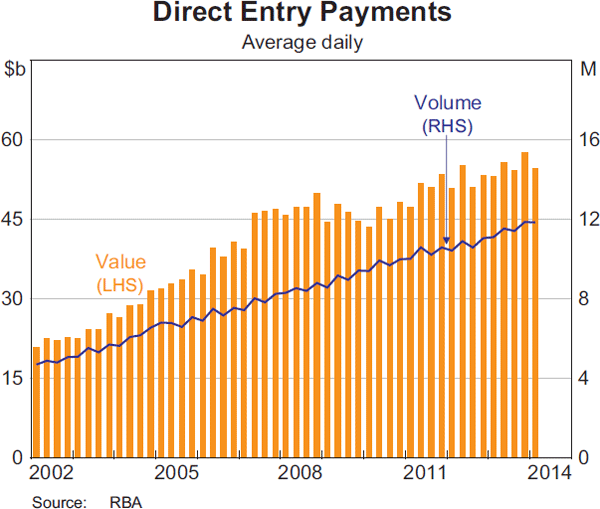
Following the exchange of payment details between direct participants in a clearing system, the obligations owed between participants as a result of those exchanges are collated and sent to RITS for settlement as part of a multilaterally netted batch. In the event that one or more of the participants in a multilateral settlement were unable to settle their obligations in RITS due to insufficient funds, the entire settlement would be delayed. This has the potential to disrupt the payments system significantly and might cause other banks that are waiting for payment to source liquidity elsewhere. Such a scenario increases in severity with the size of outstanding payment obligations owed by the affected ESA holder.
The deferred settlement of payments on a multilaterally netted basis in RITS allows for the accumulation of potentially quite large obligations between participants. The longer the period between settlements, the larger these credit exposures can become, and the greater the opportunity for an institution to default on these obligations. Over time, the value of direct entry obligations has grown to reach around 9 per cent of the total value of RITS interbank settlements. Hence, the move to settling direct entry payments on a same-day basis rather than on the following day provides a significant reduction in settlement risk. It has the additional benefit of allowing funds to be made available to recipients on a more timely basis without the receiving institution taking on credit risk.
The introduction of same-day settlement of direct entry obligations was a strategic objective of the Payments System Board, identified in its Strategic Review of Innovation in the Payments System.[5] The Review was announced in May 2010, with the aim of identifying potential gaps in Australian retail payments systems that might benefit from innovation through more effective cooperation between stakeholders and regulators. The Review concluded that there was a need to provide a system of near real-time retail payments in the next few years, which the industry is currently developing as the New Payments Platform.[6] The Review also saw scope to enhance the services that can be offered by the existing direct entry system, including by settling direct entry payments in a more timely fashion in RITS. One important consideration was the increasingly common practice of banks providing access to incoming direct entry funds to their customers on a more timely basis in order to be competitive.
Operational Arrangements for Same-day Settlement
Direct entry participants submit electronic settlement instructions directly to RITS after each official clearing exchange using the RITS Low Value Settlement Service (LVSS). These obligations were settled on a deferred, multilaterally netted basis at 9.00 am with the other low-value payment obligations from the previous day until same-day settlement was introduced for direct entry obligations on 25 November 2013. Direct entry payments, which comprise around 75 per cent of the value of low-value debit and credit transactions cleared between institutions, have since been able to be settled for same-day value.
Direct entry payments are settled as part of a netted multilateral settlement on the same day they are cleared, and shortly after the official industry clearing exchange times, at 10.45 am, 1.45 pm, 4.45 pm, 7.15 pm and 9.15 pm (Figure 1).[7] The introduction of five intraday settlements has significantly reduced the delay between payment clearing and settlement for the vast bulk of the value of direct entry obligations settled. Direct entry obligations that do not settle on the day of clearing may be resubmitted with all other low-value clearings for settlement on a net deferred basis at 9.00 am the next business day.[8]
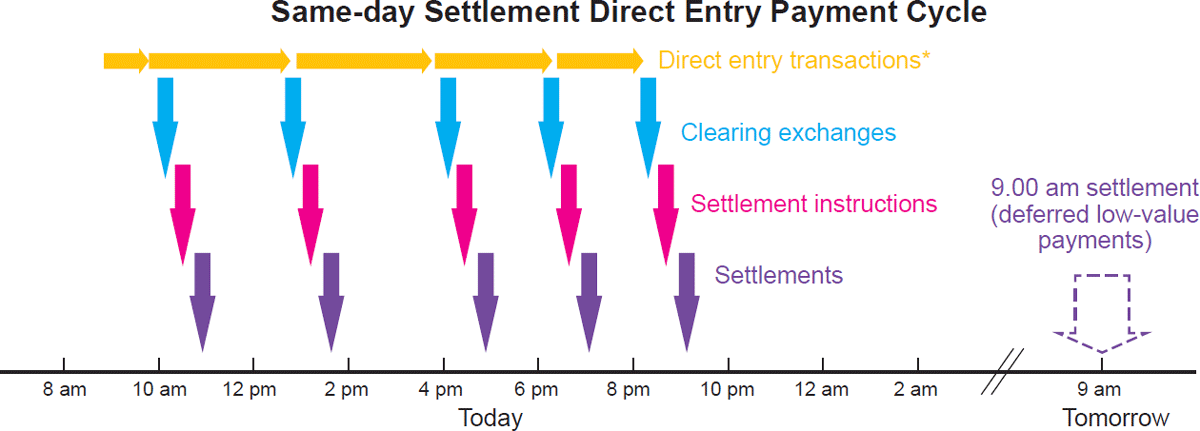
This figure shows that direct entry obligations accumulate from one clearing exchange time to the next. At the time of each clearing exchange (10.00 am, 1.00 pm, 4.00 pm, 6.30 pm and 8.45 pm), obligations are cleared. Shortly thereafter, the resulting settlement instructions are sent to RITS, which are then settled in RITS at 10.45 am, 1.45 pm, 4.45 pm, 7.15 pm and 9.15 pm respectively. At 9.00 am the following business day there is another settlement, for deferred low-value payments.
Under the new arrangements, eligible settlement instructions are aggregated at the scheduled start time of each multilateral settlement, creating one net settlement position (to pay or receive) per participant (Table 1). These positions are then tested against available funds in each participant's ESA, and when all net-paying participants have sufficient funds in their ESA, all positions are settled simultaneously.
| Official clearing exchange time | Multilateral settlement testing | |
|---|---|---|
| Start | End | |
| 10:00 | 10:45 | 11:15 |
| 13:00 | 13:45 | 14:15 |
| 16:00 | 16:45 | 17:14 |
| 18:30 | 19:15 | 19:45 |
| 20:45 | 21:15 | 21:30 |
|
Source: RBA |
||
A key consideration in moving to same-day settlement was the need to extend RITS settlement hours to accommodate the same-day settlement of obligations arising from evening direct entry exchanges. Previously, the RITS ‘Evening Settlement Session’ closed at 6.30 pm Australian Eastern Standard Time (AEST) (8.30 pm Australian Eastern Daylight Time (AEDT)) following settlement of foreign exchange transactions using CLS, which operates in the European morning.[9] As there is an official clearing exchange for direct entry at 8.45 pm and a subsequent multilateral direct entry settlement in RITS at 9.15 pm, RITS operating hours have been extended until 10.00 pm Monday to Friday all year (Figure 2). For those direct entry participants that did not previously participate in the Evening Settlement Session (the majority of direct entry participants), managing direct entry settlement activity in the Evening Settlement Session was a significant change.
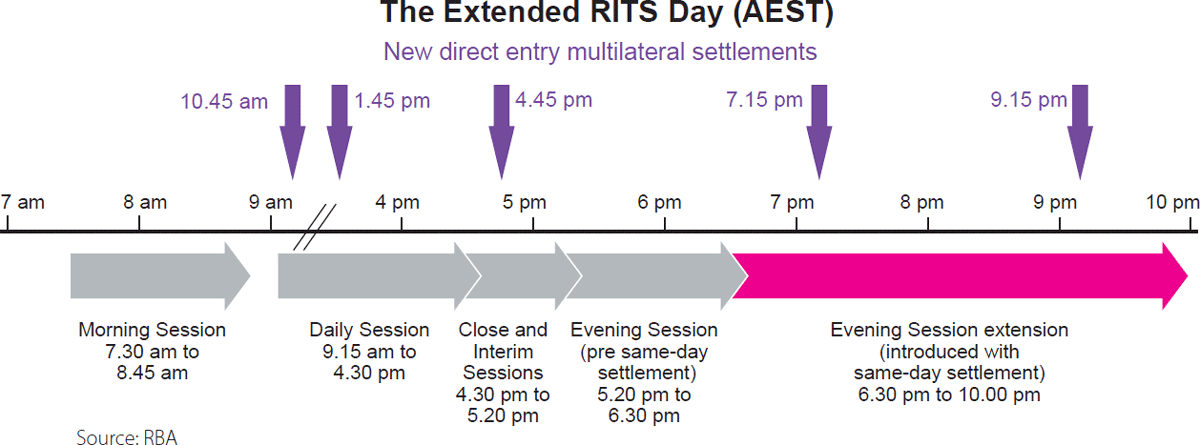
This figure shows the different settlement session times across the RITS day, including the Morning, Daily, Close, Interim and Evening Sessions. It shows that the two evening direct entry settlements, at 7.15 pm and 9.15 pm, occur at a time when RITS was previously closed in Australian Eastern Standard Time. The closing time of the RITS Evening Session has now been extended, from 6.30 pm to 10.00 pm, all year so that the two new evening direct entry settlements are able to be settled.
Box A: Netting
Direct participants submit settlement instructions to RITS via the LVSS once direct entry payments have been outwardly cleared through the bilateral exchange of files that contain the underlying transaction details. The obligations arising from each of these exchanged files already contain an element of netting since a file may contain both credit and debit transactions. The settlement instruction is for the net of the credits less the debits contained in the file submitted by, for example, participant A against participant B (Figure A1). Similarly, participant B may send a clearing file to participant A – containing different transactions – in which the underlying credit and debit transactions also may net to either an overall credit or debit. This value is reflected in the settlement instruction sent to RITS. To calculate the bilateral net position between participants A and B, the two settlement instructions can be netted off against one another, resulting in a single obligation owed by one participant to the other.
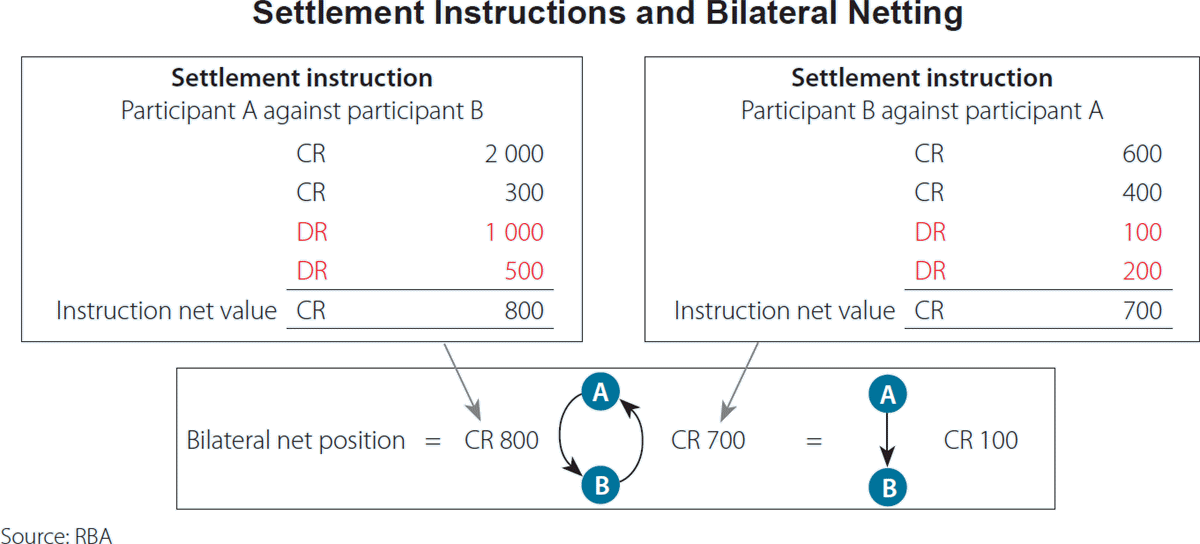
A multilaterally netted settlement refers to the case where three or more bilateral positions are netted off against one another. For example, imagine participants A, B, C and D have bilateral obligations with each other as shown in Scenario A of Figure A2. If each of these positions was settled bilaterally (i.e. with no multilateral netting), a total of 410 of liquidity would be needed to settle all of these positions (30+60+70+70+80+100).
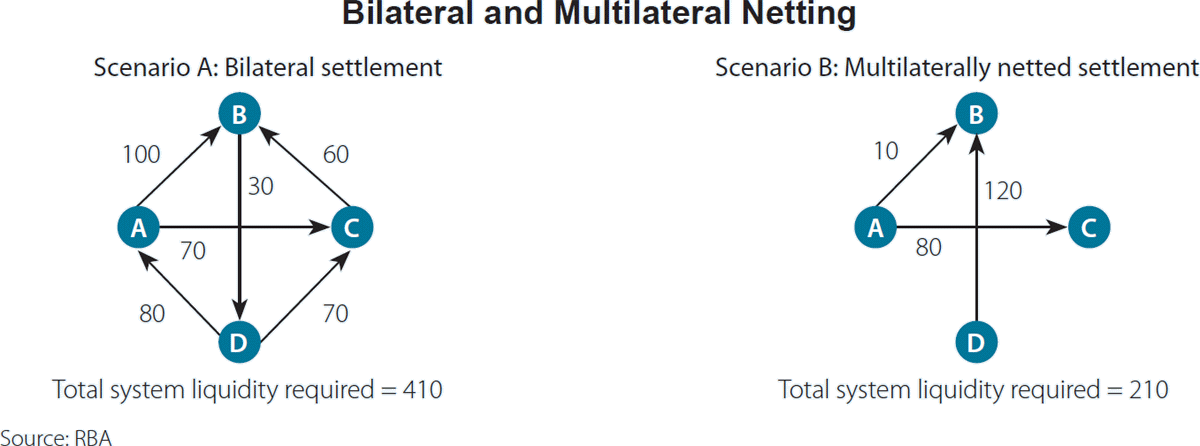
In a multilaterally netted settlement, the final obligation owing to or by each participant is the sum of the individual bilateral positions, and all participants' multilaterally netted obligations must sum to zero. If the obligations in Scenario A were settled on a multilaterally netted basis, the resultant multilateral settlement positions would be reduced as shown in Scenario B. The total value of liquidity required to settle these positions would be reduced to 210 under multilateral netting, which implies a reduction of 200, or nearly half the amount of liquidity required.
This concept is applicable to any number of participants greater than three. The number of bilateral settlements grows exponentially as the number of participants does.[1] In Scenario A, the six bilateral settlements are reduced by multilateral netting to three in Scenario B.
Changes to Liquidity Arrangements
ESA balances must remain positive at all times. Since the commencement of RTGS in 1998, ESA holders have been able to access intraday liquidity from the Reserve Bank by selling securities under repurchase agreement (repo).[10] Provision of adequate intraday liquidity by the RBA promotes the smooth distribution of settlements over the course of the RITS payment day.
Prior to the introduction of same-day settlement, transactions scheduled for settlement in the RITS Evening Settlement Session were generally known to ESA holders by about 6.05 pm, which meant that ESA holders were sure of their end-of-day positions before the close of the interbank overnight cash market at 6.30 pm AEST (8.30 pm AEDT).
However, because the final direct entry clearing exchange now occurs after the interbank cash market has closed (as does the second last, for part of the year), ESA holders no longer know with certainty what settlement obligations require funding in the Evening Settlement Session. Hence, direct entry participants are unable to ‘square up’ their daily funding requirements at the time that the cash market closes. Moreover, RITS participants are not able to initiate new liquidity transactions (repos) after the cash market closes because the securities settlement system, Austraclear, also closes at that time. Therefore, in order to ensure direct entry participants have sufficient ESA liquidity to settle their direct entry obligations after the close of the interbank cash market, the Reserve Bank altered arrangements for the provision of liquidity to ESA holders.
Direct entry participants now require significantly higher precautionary ESA balances to meet their (unknown) evening direct entry settlement obligations. This is facilitated by a new liquidity instrument – an open RBA repo (i.e. a repo with no specified end date). The Reserve Bank set a minimum value that each direct entry participant is required to hold for their open repo, and also set a maximum amount able to be contracted by each participant; up to this amount, open RBA repos are contracted at the cash rate target. Open RBA repos taken out in excess of this limit are contracted at a higher interest rate (the cash rate target plus 25 basis points).
As an offset to the cost of open RBA repo positions, overnight funds in the respective participants' ESAs, adjusted for the value of evening direct entry settlements (the final two multilaterally netted settlements), are recompensed at the cash rate target. As a result, the open RBA repo is effectively costless to the holder, as long as their end-of-day ESA balance, excluding the evening direct entry settlements, is at least equal to their open RBA repo position. The ESA funds received from these repos provide sufficient liquidity for settlement of evening direct entry obligations. The changes to liquidity arrangements have been implemented so as not to affect the model used to implement monetary policy. The new arrangements preserve the existing 50 basis point ‘corridor’ around the Reserve Bank's cash rate target.[11] The new liquidity arrangements were also designed to accommodate the New Payments Platform being developed by the industry, which will allow for 24 hours a day, 7 days a week real-time settlement of payments for businesses and consumers.
Impact of Same-day Settlement
Around 75 per cent of the value of payments previously settled on a deferred basis in RITS at 9.00 am is now settled on a same-day basis. There has been a decline in netting efficiency in moving from settling direct entry value in one batch to settlement across five multilateral settlements. The new liquidity facility has resulted in a significant increase in system liquidity and a sharp decline in the use of intraday repos.
Operational efficiency
In May 2012, participants commenced providing their direct entry settlement instructions to RITS at the time of exchange (although from May 2012 to November 2013 settlement of these instructions remained part of the next day's 9.00 am settlement). Since the move to same-day settlement, participants have around 45 minutes following the official clearing time to ensure that all settlement instructions for that multilateral settlement are submitted to RITS (see Table 1); hence, the move to same-day settlement has increased the importance of these instructions arriving at RITS close to their exchange time. If a settlement instruction is not submitted in time for its scheduled multilateral settlement it will be settled in the next settlement; and settlement instructions that miss the final multilateral settlement of the day will generally need to be settled on an ‘individual’ (i.e. RTGS) basis before the end of the Evening Settlement Session, or they will need to be settled as a part of the next business day's 9.00 am deferred settlement.
Since the introduction of same-day settlement, instructions have generally been submitted in a timely manner and very few have missed the instruction input cut-off time for a settlement.
Settlement activity
An average of $16.5 billion of direct entry transactions has settled on a same-day basis in RITS each business day since the introduction of same-day settlement. The standard deviation of the daily value is $3.8 billion.
The average value settled shows a clear pattern across the five daily settlements (Graph 2 and Graph 3). Most of the value of direct entry payments, around 58 per cent, is settled in the 7.15 pm and 9.15 pm settlements. This is likely to reflect participants' customers sending them direct entry transaction files late in the day, and this trend reinforces the importance of having liquidity arrangements that accommodate these new evening settlements. Relative to the value settled in each exchange, the 10.45 am settlement is subject to the most variability. In absolute terms, the greatest variability is in the exchange with the largest value settled, which is the 7.15 pm settlement.
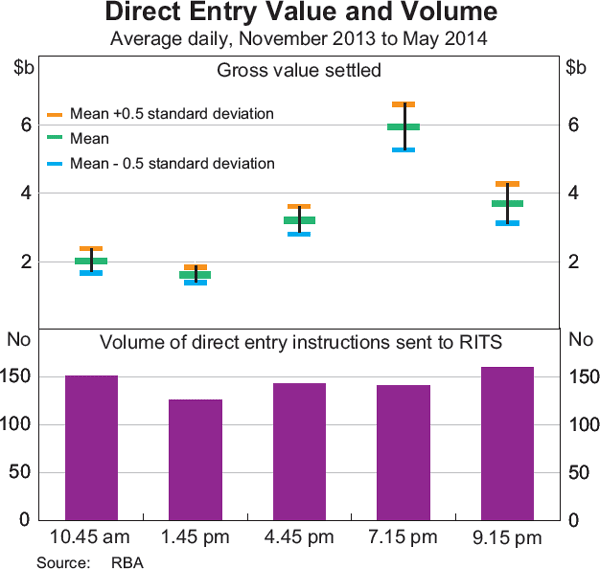
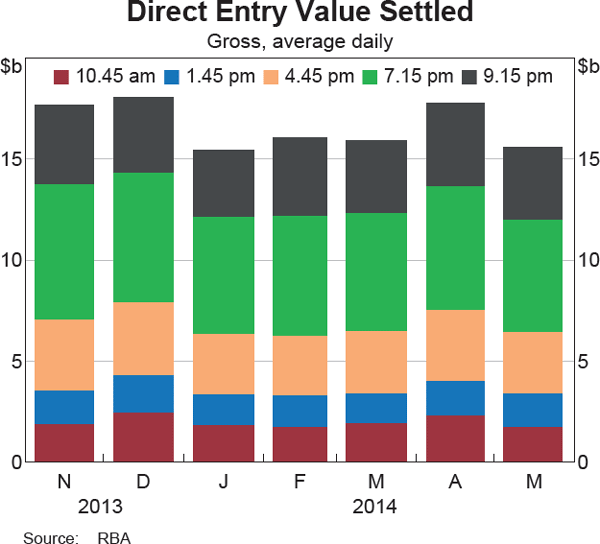
The distribution of direct entry settlement value across the five new settlement times is consistent with clearing exchange patterns observed prior to the introduction of same-day settlement. This was a crucial input to the design of the liquidity solution. Settlement patterns of same-day direct entry payments and the adequacy of the size of participants' open RBA repo positions continue to be monitored by the Reserve Bank for any unexpected shifts in payments activity that might have implications for the newly introduced liquidity solution.
Not surprisingly, the distribution of the number of direct entry settlement instructions submitted to RITS for same-day settlement has been more uniform than the distribution by value across the five clearing exchanges. The number of instructions is driven by the number of participants that choose to exchange files at any time, whereas the distribution of values depends on the distribution of customers' transactions (Graph 2). On average, around 720 settlement instructions, from 13 direct participants, are submitted to RITS each business day, representing over five million individual credit and debit transactions. The volume of settlement instructions submitted to RITS peaks in the first and last exchanges of the day.
The volume of settlement instructions submitted to RITS in each clearing exchange is relatively static over time, and has not exhibited any day-of-the-week or seasonal patterns to date, as settlement instruction volumes are primarily driven by operational arrangements rather than settlement activity. Participants generally exchange instructions at the same time each day with the same counterparties; that is, participants exchange files and send instructions to RITS even if they have no payment obligations with a counterparty in an exchange (i.e. the file is for zero value) as an operational signal that their counterparty does not need to wait for a file from them.
Netting efficiency
Settling transactions on a netted basis has the significant benefit of economising on liquidity requirements. That is, by netting off the obligations between two or more settlement participants, the total value of funds required to achieve settlement can be reduced. Prior to the introduction of same-day settlement for direct entry obligations, an average of $21.4 billion of customers' transactions relating to direct entry, cheques and debit and credit card transactions were settled as a part of the 9.00 am settlement each business day. Before being submitted for settlement testing, these obligations were netted on a multilateral basis between participants leading to, on average, just $3.9 billion of net settlement positions,[12] representing 91 per cent netting efficiency.[13]
Direct entry settlement arrangements have moved from settling one business day's worth of direct entry payments in one multilateral settlement (with other low-value payments), to settling one business day's worth of direct entry payments in five (direct entry only) multilateral settlements.[14] The dispersion of direct entry across the five new same-day settlements has caused a considerable reduction in netting efficiency. Since November 2013, gross low-value settlement obligations have been little changed at an average of $21.3 billion, and the sum of net settlements representing these obligations (the five new multilateral settlements and the remaining 9.00 am settlement) has grown to $7.2 billion (Graph 4). This now represents 83 per cent netting efficiency for these payments, 8 percentage points lower than prior to the introduction of same-day settlement.
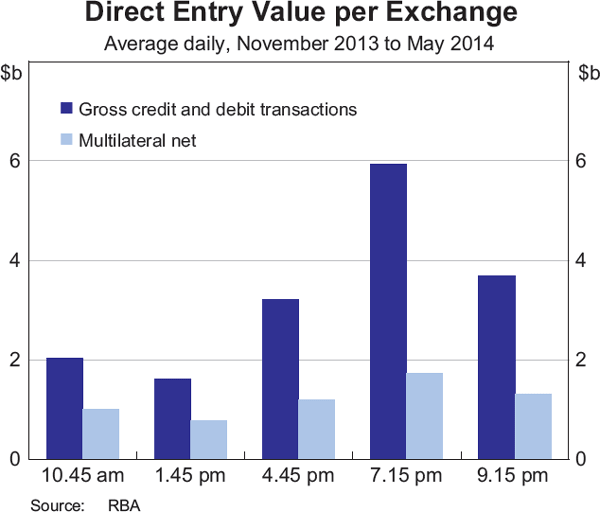
System liquidity
The introduction of open repos has significantly diminished the demand for intraday repos used to support settlement activity. Ten participants are required to hold open RBA repo positions as a liquidity buffer for evening direct entry settlements. The open RBA repos contracted by these participants have largely replaced their use of intraday repos. In aggregate, participants have taken out around $21 billion in open RBA repos, while the use of intraday repos each business day has fallen by around $8 billion (Graph 5). With the increased level of system liquidity provided by open RBA repos, the liquidity ratio, which measures average liquidity as a share of the total value of RTGS payments settled, has increased by around 7 percentage points, to a record high of 15 per cent.
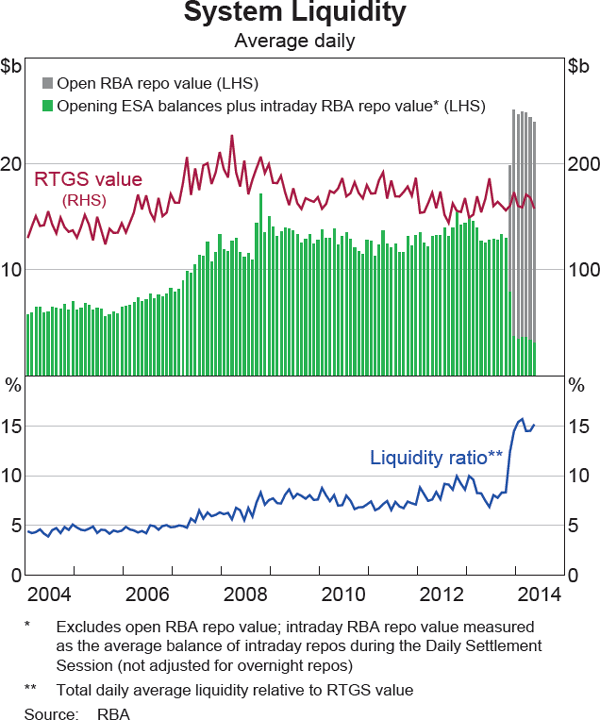
The new liquidity facility ensures that direct entry participants with a net-paying position on any given day have sufficient ESA balances to fund their evening direct entry obligations. This can be expressed as the ratio of a participant's evening net-paying direct entry obligations to their open repo position, which for the median participant is less than 10 per cent, on average. All direct entry participants, including those whose ratio is higher than the average median, hold appropriate ESA balances should larger-than-expected settlement obligations arise in the evening (Graph 6).
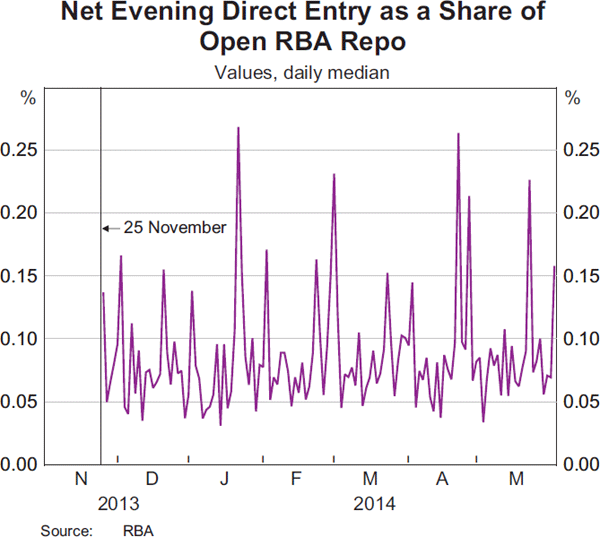
Conclusions
The introduction of same-day settlement of direct entry obligations is part of the Reserve Bank's ongoing efforts, in collaboration with financial institutions and industry bodies, to further strengthen Australia's settlement infrastructure. The move to same-day settlement of direct entry obligations has proceeded smoothly, with participants meeting the operational and liquidity requirements of the new settlement arrangements without incident.
Footnotes
Sascha Fraser completed this work in Payments Settlements Department and Adriarne Gatty is from Payments Settlements Department. [*]
For more detail on RTGS settlement operations, see Gallagher, Gauntlett and Sunner (2010), and see ‘Box A: Netting’ for a detailed explanation of multilateral netting. [1]
These payments are termed ‘low-value’ based on the payment system through which they are cleared, not because all reflect transactions of low value; some payments which are high in value are also settled via the low-value payments system. [2]
References to direct entry in this article exclude payments made using the government direct entry system (GDES), which are settled separately in RITS. [3]
This includes government direct entry transactions and direct entry transactions that do not require settlement at the interbank level, for instance because the payer and beneficiary hold accounts at the same institution. In addition, some financial institutions appoint another institution as an agent to clear and settle on their behalf such that obligations between an ‘indirect’ participant and its direct participating institution, or between two ‘indirect’ participants who use the same direct participant, would not settle at the interbank level. [4]
For conclusions of the Review, see RBA (2012). [5]
Further information on the New Payments Platform is available on the APCA website at <http://www.apca.com.au/about-payments/future-of-payments/new-payments-platform>. [6]
There is a sixth official clearing exchange at 10.30 pm; however, payments cleared in this exchange are settled on the following RITS day in the low-value payments deferred 9.00 am settlement – these direct entry payments are also value dated the following business day. [7]
Functionality exists in RITS for any low-value settlement obligations to settle individually on the RITS queue (without being multilaterally netted), similar to other interbank payments in RITS. This is predominantly used for the settlement of government direct entry obligations, but the functionality can also be used in contingency scenarios. [8]
CLS is a multi-currency settlement system designed to reduce foreign exchange settlement risk. [9]
A repo is the sale or purchase of one or more securities, with an undertaking to reverse the transaction at an agreed date in the future and at an agreed price. [10]
More information on the Reserve Bank's monetary policy implementation is available at <http://www.rba.gov.au/mkt-operations/dom-mkt-oper.html>. [11]
This figure represents the absolute sum of both payments and receipts, since obligations in any multilaterally netted system will sum to zero. [12]
Calculated as net direct entry payments and receipts ($3.9 billion) divided by gross direct entry payments and receipts ($21.4 billion × 2). [13]
Excluding payments cleared as a part of the 10.30 pm direct entry exchange (see footnote 6). Prior to same-day settlement, one business day's worth of transactions was settled each weekday, except for the second business day following weekends and public holidays, when any additional days' transactions were also settled. [14]
Footnote Box A
The number of bilateral settlements is [(N2 − N)/2], where N is the number of participants. [1]
References
Gallagher P, J Gauntlett and D Sunner (2010), ‘Real-time Gross Settlement in Australia’, RBA Bulletin, September, pp 61–69.
RBA (Reserve Bank of Australia) (2012), Strategic Review of Innovation in the Payments System: Conclusions, June.